Barley Pilaf with Rose Harissa, Tomatoes & Olives
Harissa barley pilaf is the perfect quick-and-easy weeknight meal. This vegan barley recipe – with rose harissa, tomatoes and olives – is nutritious and utterly delicious. Any leftovers make a great work lunch!
This barley pilaf is a flavourful one-pan barley recipe. The rose harissa adds a subtle floral flavour and a not-so-subtle spicy hit. And the combination of salty olives, sweet tomatoes, fresh parsley leaves, zesty lemon and nutritious leafy greens will have you coming back for more.
Best of all? It’s super easy to make and very versatile – perfect for meal prep.
Enjoy it as a main dish or a barley side dish. The harissa pilaf is also a delicious base for a vegetarian grain bowl or make-ahead work lunch – top it with sliced avocado and leftover veggies, and you’re good to go!
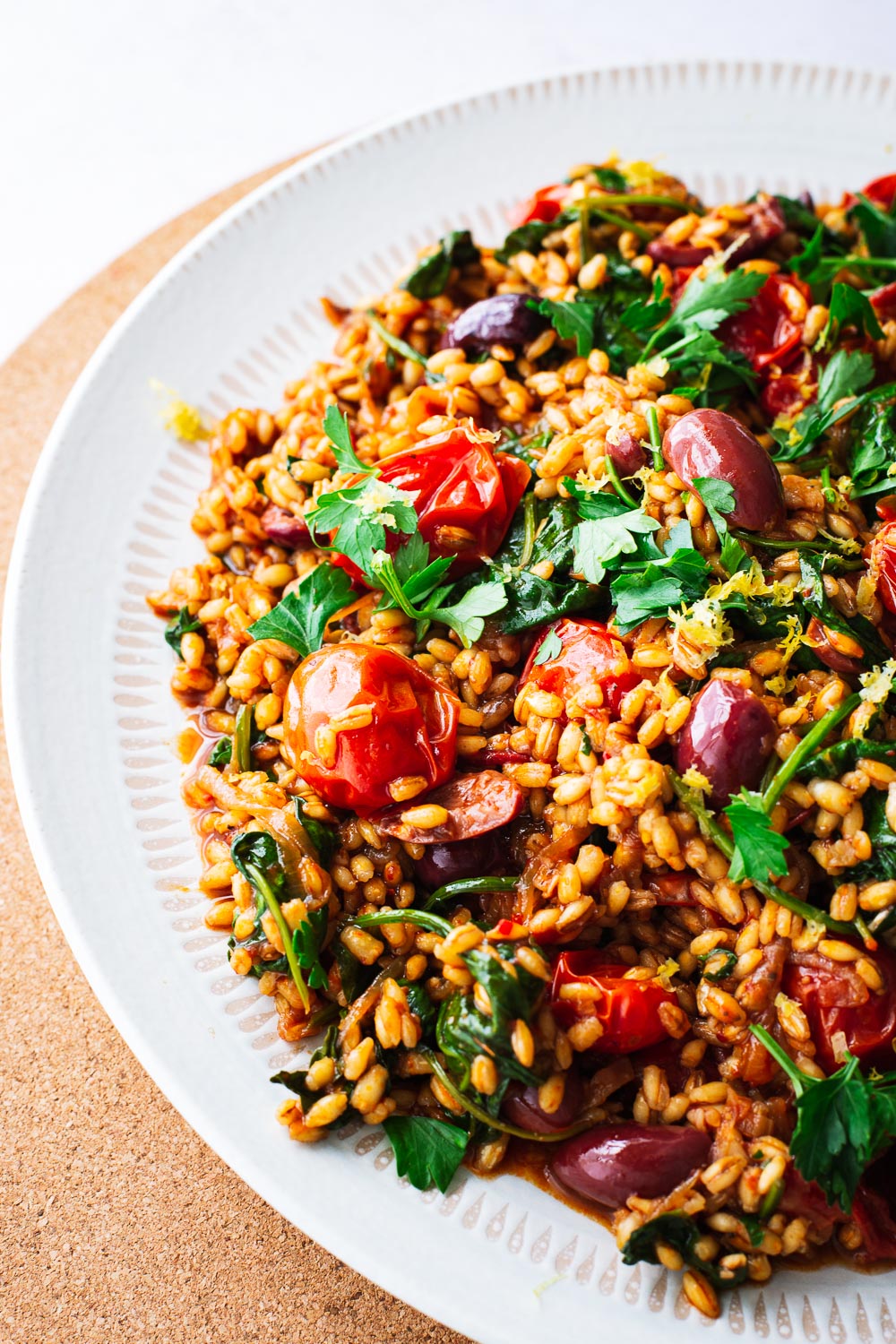
Why I love this recipe
- It’s an easy one-pot meal: All you need is a large skillet or frying pan with a lid. And with a few simple ingredients, you can have it on the table in 40 minutes.
- It’s flexible: Don’t worry if you don’t have all the ingredients ready to go. I suggest plenty of substitutes and alternatives in the next section. This easy barley recipe is very forgiving.
- It’s versatile: Serve warm as a side dish, a vegetarian main, or a grain bowl base. Top it with leftover veg, avocado, and nuts for a more substantial meal.
- It’s freezer-friendly: You can freeze leftovers in an airtight container for up to three months. Defrost the pilaf, then reheat it in your skillet to warm through.
And did I mention it’s also nutritious and utterly delicious?
What is barley pilaf?
Pilaf is traditionally a rice dish, though some regions use wheat. It involves cooking grains in stock with spices, vegetables or meat.
The goal is to achieve cooked grains that do not stick.
This barley pilaf is not traditional. But pearled barley is my all-time favourite grain. The flavour is nutty and earthy, and the texture is delightfully toothsome.
And pearl barley grains do not stick – perfect for foolproof pilaf.
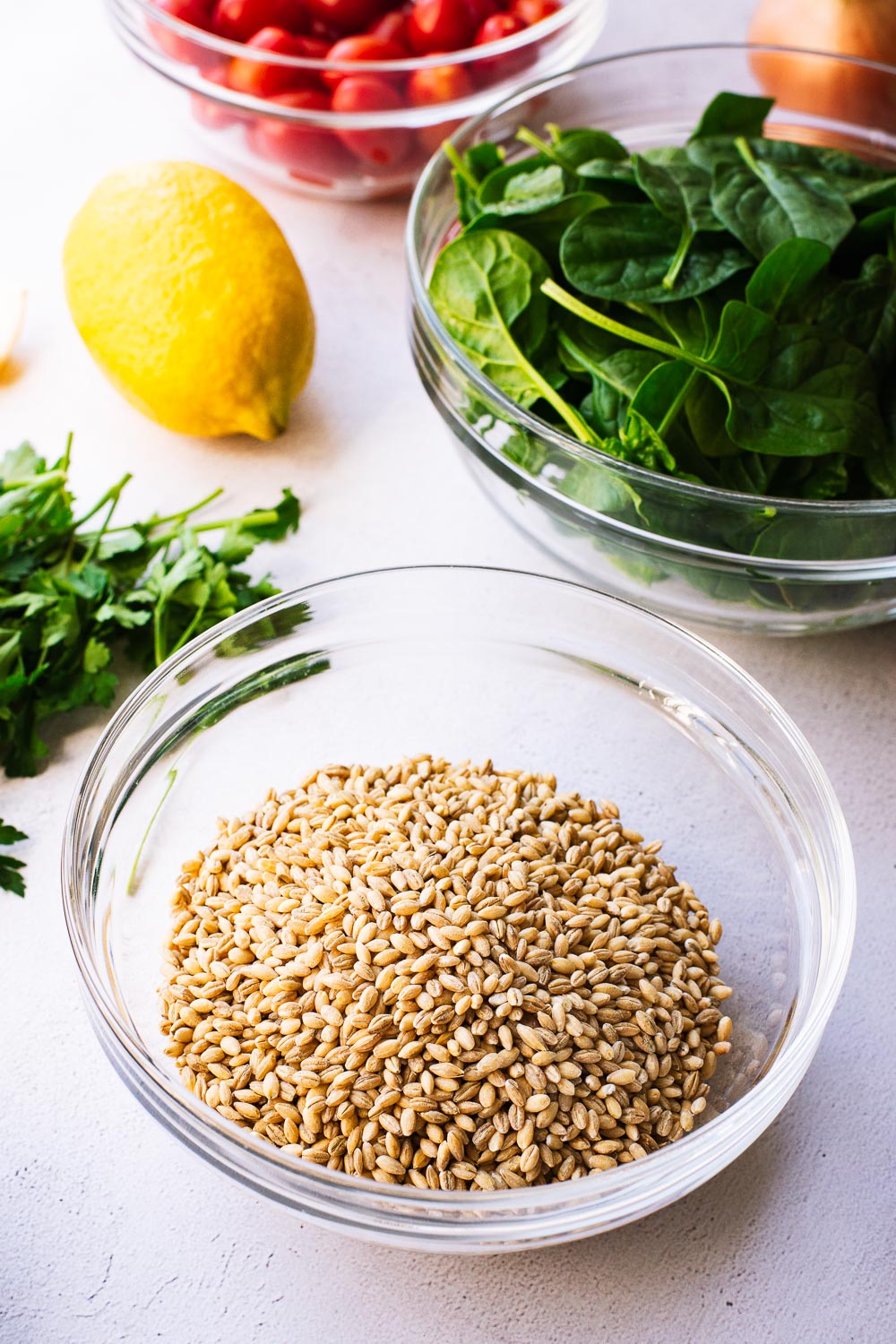
Ingredients and substitutions
This recipe is super flexible. Go ahead and substitute ingredients to suit your pantry and palate:
- Barley: I use pearl barley because it cooks quicker. But you can also use hulled barley – give the whole grain an extra 10 minutes to cook. And add a splash of water if the pan dries out too quickly. Or try it with brown rice for a more traditional rice pilaf. You can even use pre-cooked instant pot barley to save time!
- Olive oil: I use extra virgin olive oil for flavour. But you can also use vegetable oil if you prefer.
- Harissa: The spicy red pepper paste adds loads of flavour. I use rose harissa paste but you can use any harissa. Or if you don’t have any harissa, try the recipe with a harissa substitute.
- Aliums: Use a large or medium onion and two cloves of garlic. Or switch things up and opt for green onions or shallots.
- Tomatoes: Cherry tomatoes are perfect in this pilaf. They are small and sweet. But you can also use rosa tomatoes, grape tomatoes, or another small varietal. Or add diced Roma tomatoes for a saucier pilaf.
- Vegetable stock: I use vegetable stock for this recipe. But you can also use chicken stock or chicken broth if you don’t need this barley side dish to be plant-based.
- Olives: I prefer whole olives as they taste better than the pitted ones. But you can use your favourite.
- Lemon: This recipe calls for lemon juice and zest. You can substitute with lime juice and zest. Or add a drizzle of pomegranate molasses to your finished dish for a sweet acidic kick.
- Spinach: You can use kale, Swiss chard or another green leafy veg.
Related recipes
- How to make easy harissa paste from rehydrated dried chiles – quick and easy.
- How to make rose harissa paste by roasting fresh red peppers – sweet and deeply flavoured.
- How to make a quick harissa paste from harissa powder – a cheat’s quick and easy recipe.
Change the flavour of this barley side dish depending on what you have available.
- Add those leftovers lurking at the back of your fridge.
- Add more quick-cooking vegetables like green beans, snow peas or red bell peppers.
- Sprinkle with toasted nuts and seeds or any herbs that need to be used up.
- Spice things up with a sprinkle of chilli powder – I love Aleppo pepper flakes or try cayenne pepper for extra spice.
Quick pilaf with leftover cooked barley
Pilaf is a great way to jazz up leftover cooked barley (or other cooked grains).
Replace the 1 ⅓ cups of uncooked barley with 4 cups of cooked barley. Add the barley without the vegetable broth in step two and heat the barley through. Add a splash of water to loosen the mixture, if necessary. Then jump to the last step.
Just remember to taste – you may need to adjust the seasoning.
Related Post: How to Cook Barley (Instant Pot or Stovetop)
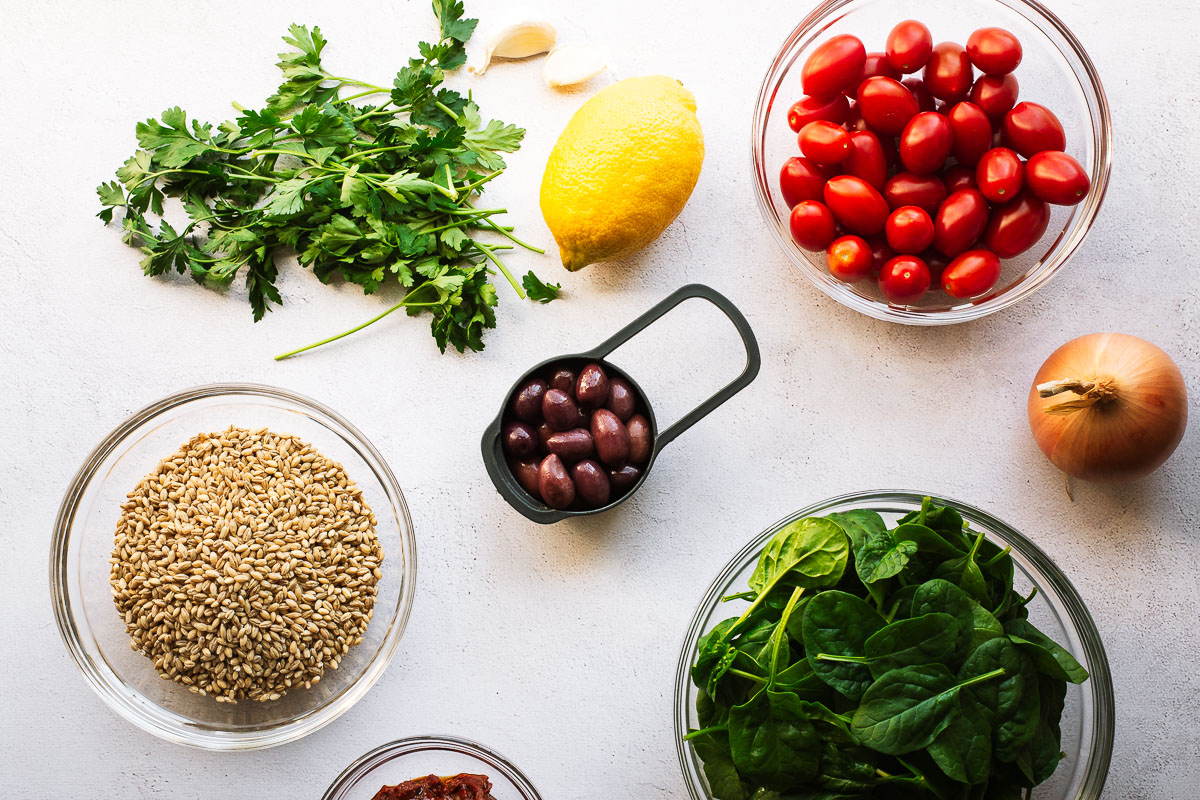
How to make pearl barley pilaf
I love the combination of salty olives, sweet tomatoes, fresh parsley and lemon zest with the spicy yet floral rose harissa.
But you can add any fresh veggies you’re in the mood for. The steps remain the same. Cook your raw veggies, add your pearl barley and vegetable stock, finish it off with a few cooked veggies and sprinkle with more fresh flavours!
Step 1: Cook the raw ingredients
Start by gathering your ingredients and place a large frying pan (for which you have a lid) on medium-high heat.
Then add the olive oil and chopped onion and cook until the onions are soft and golden, stirring frequently. It should take about 8 minutes. Turn it down to medium heat if your onions are browning too quickly.
Add the garlic and cook for another minute or two until fragrant. Don’t let the garlic burn.
This is where I stir in the harissa paste and the tomatoes. But you can add mushrooms or any raw veg you have lurking in your fridge. Vegetable barley pilaf is a great way to use up those odds and ends.
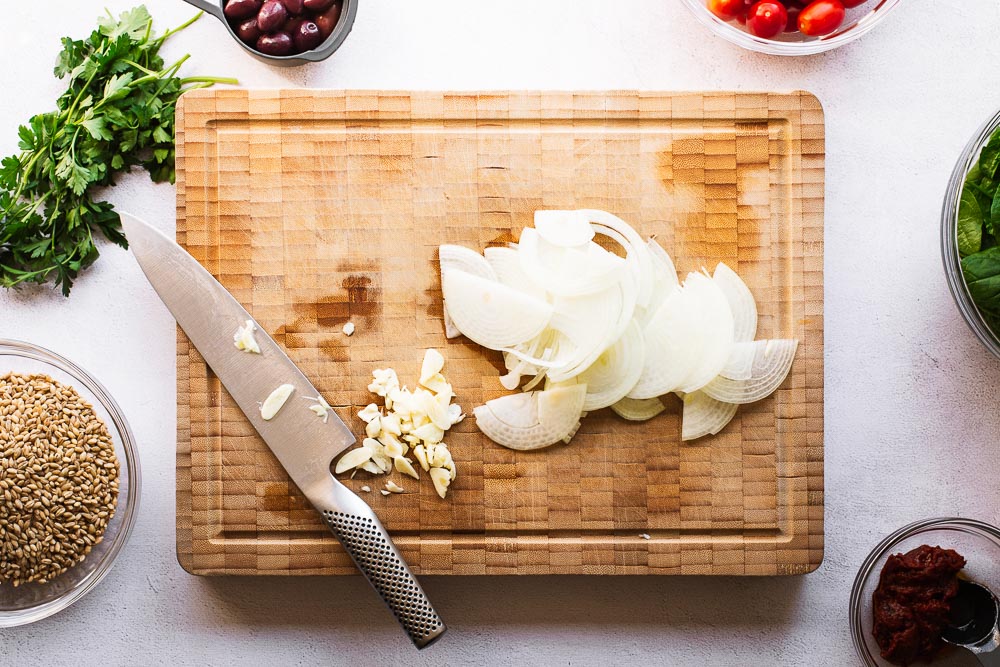
Step 2: Add the uncooked pearl barley and stock
Add the uncooked barley to the pan and mix it well with the harissa and onion – or whatever veggie mix you have going on. Toast together for a few minutes before adding the stock and a teaspoon of salt.
Turn the heat up high. Once it reaches a simmer, place the lid on the pan and lower the heat. Leave to simmer gently for 15 minutes.
Remove the lid and turn up the heat again for a brisk simmer until most of the liquid has evaporated and the barley is cooked but still retains a nice toothsome bite – about 10 minutes.
Add a splash of boiling water if the pan dries out too quickly.
Step 3: Stir in cooked veggies and leafy greens
Next, stir in the last of the veggies. This can be pops of flavour (like olives), leafy greens that just need to be wilted, or any ready-cooked leftover veggies (think cooked broccoli, cauliflower or pumpkin).
Remove the pan from the heat and stir through chopped fresh herbs, lemon juice and freshly ground black pepper to taste, reserving some herbs to scatter over the plated dish. Taste and adjust the seasoning if required.
Serve the pilaf straight out of the pan or spoon it into a shallow serving bowl. Scatter with lemon zest and the remaining chopped parsley.
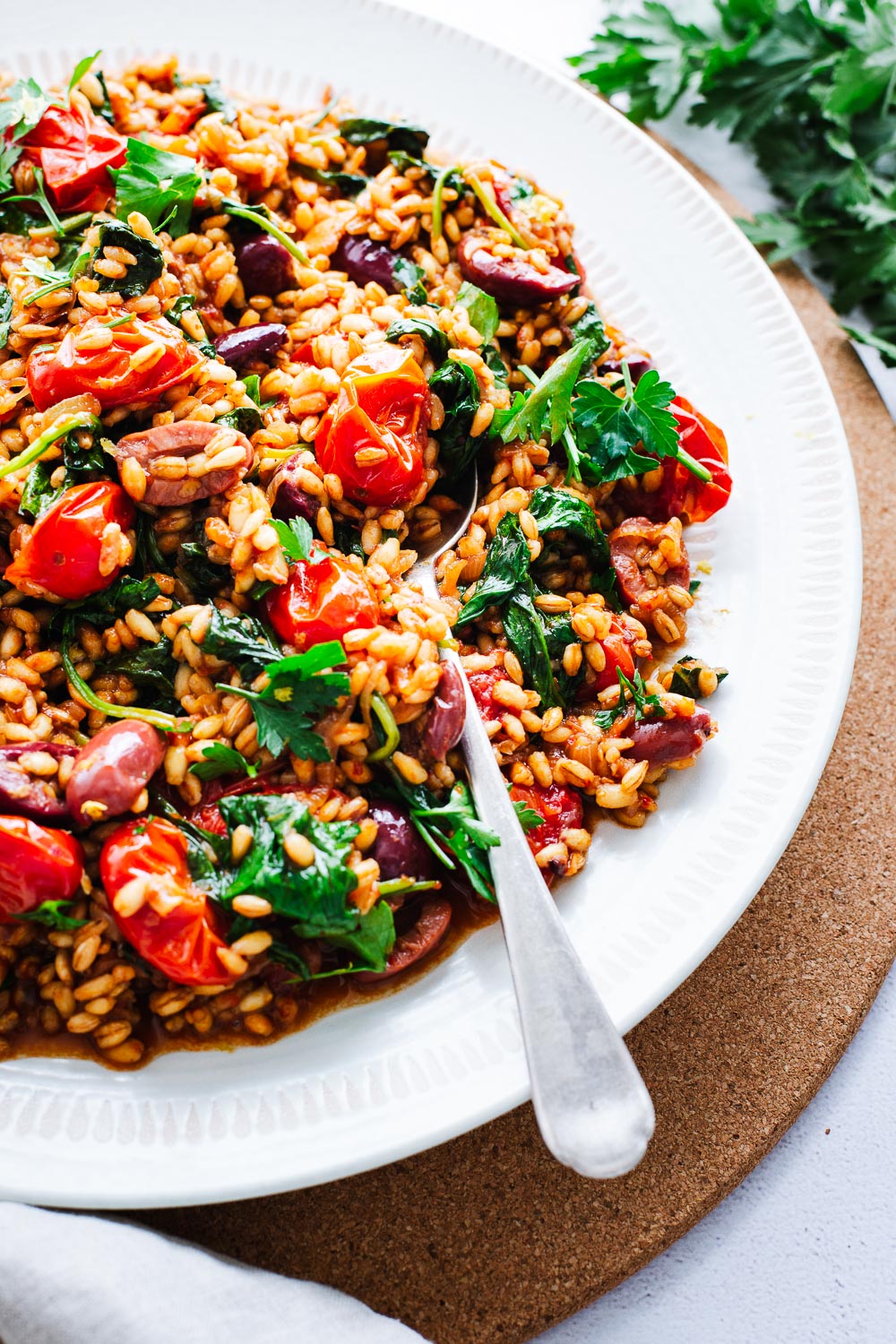
Serving suggestions
This harissa pilaf is a flavourful one-pan dish that’s perfect for an easy weeknight barley dinner or a tasty barley side dish.
Harissa pilaf as a main dish
The pearl barley pilaf recipe serves four people as a main. Just pair it with a simple green salad or a classic Middle Eastern-style salad, like Arabic chopped salad or Jerusalem salad with tahini.
The perfect side dish
It makes a great side dish for roasted chicken, grilled steak, or fish. Or serve it with a vegetarian centrepiece like roasted cauliflower with tahini. Add a bowl of simply dressed crunchy green salad leaves to complete the meal.
Easy work lunch grain bowls
Make a large batch of harissa barley pilaf, divide it into portions and refrigerate it individually. Then, every morning before work, top the bowl with last night’s leftover veg or another handful of fresh leafy greens, some avocado, mast-o khiar (Persian cucumber and yoghurt sauce) and a scattering of slivered almonds.
Leftover barley soup
You can even turn leftover pilaf into a comforting soup. Add the leftovers to simmering chicken broth (or vegetable broth) and cook until the barley is warm. Bulk up the soup with carrots, celery or lentils for a more substantial meal.
Leftover storage
Refrigerate leftovers in an airtight container for up to 3 days. Reheat the pilaf in a pan with a little olive oil or pop it into the microwave.
Or serve the barley as a grain salad at room temperature. But don’t let cooked barley (or other grains) sit at room temperature for more than an hour.
You can also freeze leftover barley pilaf for up to three months. Defrost the barley overnight in the fridge. Then reheat it thoroughly in a stovetop skillet or the microwave.
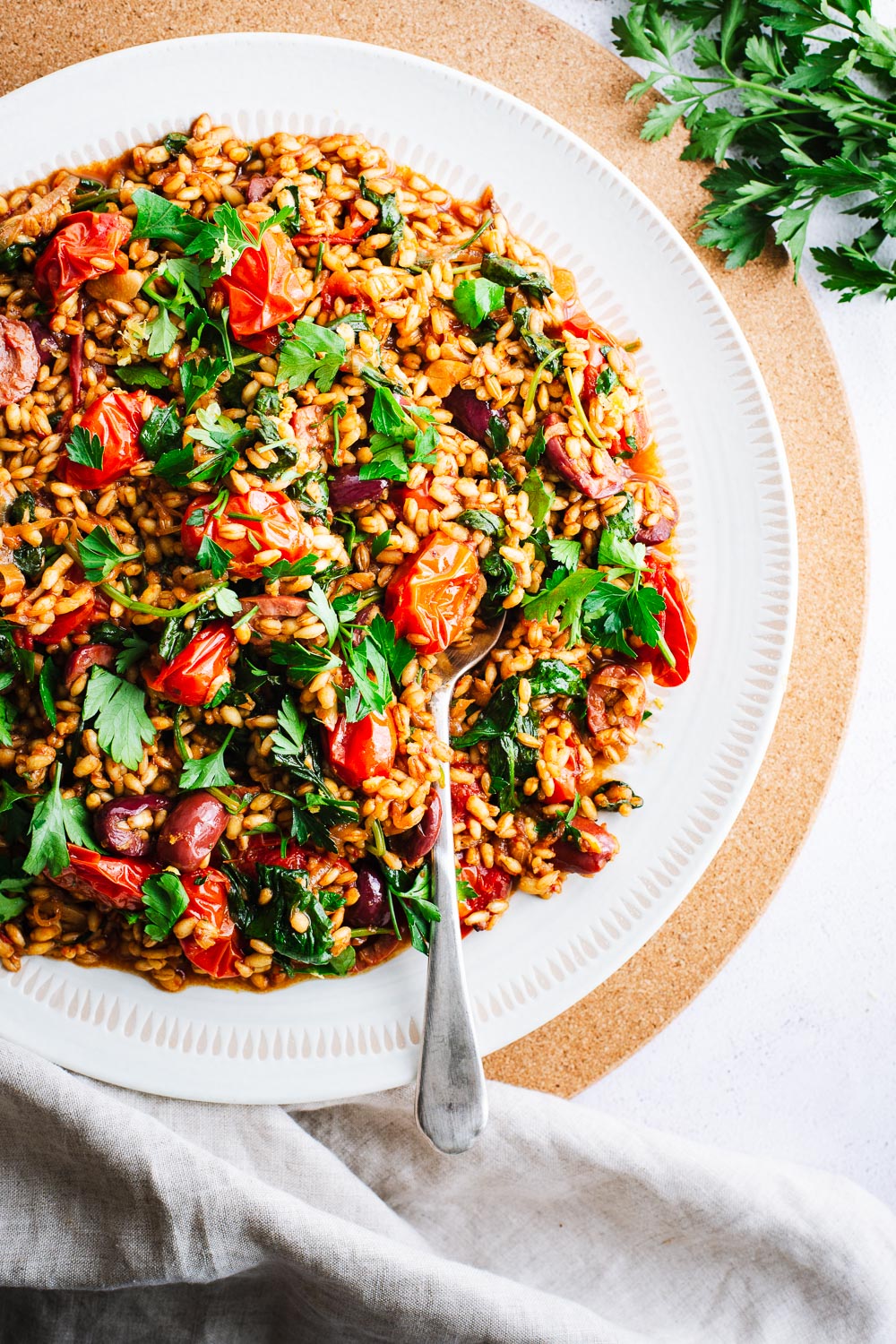
Frequently asked questions
You can easily replace rice with barley for a nutritious side dish. Barley is a heartier grain with a nutty flavour, so it pairs especially well with roast chicken, vegetables, and fish. Just keep in mind that barley cooks longer than rice.
No, barley does not taste much like rice. Barley has a nuttier and earthier flavour than rice and a chewier texture.
Yes, you can eat pearl barley like rice. Pearl barley is a polished barley with the outer hull and some, or all, of the outer bran layer removed. It is no longer a whole-grain. But it has a softer texture closer to rice.
Learn more about harissa paste
- See how to make rose harissa paste (or normal harissa paste) from roasted red bell peppers.
- Or try one of the best harissa substitutes for an instant harissa paste alternative.
- Make a fragrant dry harissa powder – a homemade spice blend from toasted whole chiles and spices – to reconstitute into harissa paste in a moment.
Try more recipes with harissa
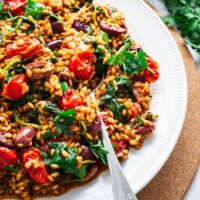
Equipment
- Large frying pan – with a fitted lid (or alternatively use a soup pot)
Ingredients
- 2 tablespoons olive oil
- 1 large onion, halved and thinly sliced
- 2 garlic cloves, peeled, bashed and sliced
- 3 tablespoons rose harissa, see notes
- 2 cups cherry or rosa tomatoes
- 1⅓ cups uncooked pearl barley*
- 2 cups light vegetable stock
- ½ cup kalamata olives (about 25 olives), destoned and torn in half
- ¾ cup parsley, roughly chopped
- 3 cups baby spinach
- 1 lemon, juice and zest
Instructions
- Place a large frying pan, for which you have a lid, on medium-high heat. Once hot, add the olive oil and the onion. Cook until the onions start to turn soft and golden, stirring frequently. It should take about 8 minutes. Reduce the heat if your onions are browning too quickly. Add the garlic and cook for another minute or two until fragrant. Take care not to let the garlic burn.
- Stir the harissa paste into the onion mixture and add the tomatoes. Cook until the tomatoes start to burst – about 3 minutes. Put the uncooked barley into the pan and mix it well with the harissa and onion mix. Allow it to toast for a minute –stirring often – before you add the stock and a teaspoon of salt. Turn the heat up high. Once it reaches a simmer, place the lid on the pan and lower the heat. Leave to simmer gently for 15 minutes.
- Remove the lid and turn up the heat for a brisk simmer until most of the liquid has evaporated and the barley is cooked but still retains a nice bite – about 10 to 15 minutes. Add a splash of boiling water if the pan dries out too quickly.
- Stir in the olives. Add the baby spinach and stir through. Remove from the heat and stir through most of the chopped parsley, lemon juice and a good grind of black pepper, reserving some parsley to scatter over the plated dish. Taste and adjust the seasoning if required. Serve the pilaf straight out of the pan or spoon it into a bowl. Scatter with the remaining parsley and lemon zest.
Notes
- This recipe uses pearl barley. If you have hulled barley, you’ll need an extra 20 minutes to cook the barley.
- I prefer unpitted olives as I believe they taste better than the pitted ones. To use, I break the olives open by hand and tear the olive flesh into two halves.
- You will need a large pan with a fitted lid for this recipe. If you don’t have one, you can use a deep pot – reducing the sauce may take longer.
- Refrigerate leftovers in an airtight container for up to 4 days or freeze for 3 months. Reheat thoroughly.
Try more Middle Eastern side dishes and sauces
- Harissa roasted cauliflower: A buttery, spicy and indulgent vegetarian main to serve with Persian yoghurt.
- Arabic salad: A classic Middle Eastern-style chopped salad to serve alongside the yoghurt side dish.
- Kuku sabzi: An easy Persian herb frittata recipe packed with greens and just enough eggs to hold it all together.
- Sumac onions: Deliciously tart sumac-marinated red onions make a versatile Middle Eastern condiment.

The flavor is very good. I took off a star because the cooking time and prep time is impossibly off. Prep time is much more than 5 minutes — 15 minutes is more reasonable. Cook time for pearl barley is closer to 45 minutes, not 25. I cook barley all the time, and this might not be obvious to folks new to barley!
Thanks for taking the time to leave a comment, Eftihia! I’m so happy you enjoyed the flavours.
I make this recipe so often that the prep takes me no time. But you’re right, prep time can take much longer when you make something for the first time – this was an oversight on my part. I increased prep time in the recipe card.
While the exact cooking time can always vary, the recommended cooking time for hulled barley is 45 minutes to 1 hour, whereas pearl barley (like I’m using in this recipe) only requires 25 to 30 minutes. I prefer the pearl barley to retain some texture when served in a pilaf, which is why I opt for 25 minutes. But if you love your barley cooked very soft, you can absolutely add some extra cooking time.
I also added a note to the recipe card to remind everyone to check that they are using pearl barley and not hulled barley.
This looks delicious! I have leftover cooked barley, can I use it in this recipe?
Hi Ella! Thank you for pointing this out. You can definitely use leftover cooked barley. Add the barley without the stock in step two and cook long enough to heat it through. Add a splash of water to loosen the mixture. Then jump to step four. I will update the post to include this.